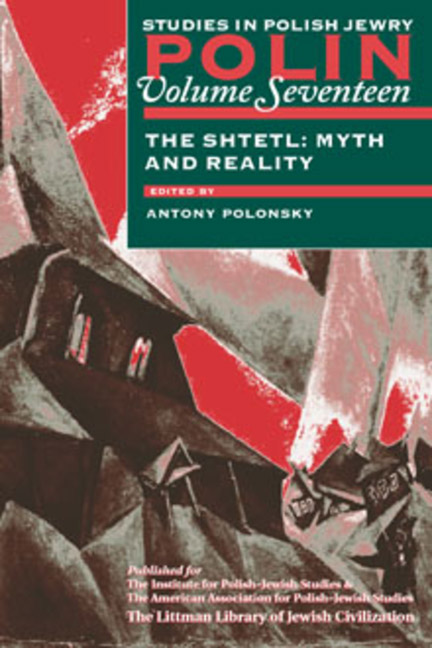Book contents
- Frontmatter
- Dedication
- Editors and Advisers
- Preface
- Polin
- Polin: Studies inPolish Jewry
- Contents
- Note on Place Names
- Note on Transliteration
- List of Abbreviations
- PART I THE SHTETL: MYTH AND REALITY
- PART II NEW VIEWS
- PART III DOCUMENTS
- PART IV THE SIXTY-FIFTH ANNIVERSARY OF EVENTS IN PRZYTYK: A DEBATE
- If Not a Pogrom, Then What?
- Pogrom? The Polish–Jewish Incidents in Przytyk, 9 March 1936
- It Was No Ordinary Fight
- Life and History
- Letter from Ryszard Fenigsen
- Przytyk and the Market Stall
- PART V REVIEWS
- OBITUARIES
- Notes on the Contributors
- Glossary
- Index
Przytyk and the Market Stall
from PART IV - THE SIXTY-FIFTH ANNIVERSARY OF EVENTS IN PRZYTYK: A DEBATE
- Frontmatter
- Dedication
- Editors and Advisers
- Preface
- Polin
- Polin: Studies inPolish Jewry
- Contents
- Note on Place Names
- Note on Transliteration
- List of Abbreviations
- PART I THE SHTETL: MYTH AND REALITY
- PART II NEW VIEWS
- PART III DOCUMENTS
- PART IV THE SIXTY-FIFTH ANNIVERSARY OF EVENTS IN PRZYTYK: A DEBATE
- If Not a Pogrom, Then What?
- Pogrom? The Polish–Jewish Incidents in Przytyk, 9 March 1936
- It Was No Ordinary Fight
- Life and History
- Letter from Ryszard Fenigsen
- Przytyk and the Market Stall
- PART V REVIEWS
- OBITUARIES
- Notes on the Contributors
- Glossary
- Index
Summary
INTO the centre of the hall, into a quadrangle enclosed on one side by the long judges’ table, on two sides by the lawyers’ lecterns, and on the fourth by a uniformed police officer, the fifty-seven people named as defendants enter one after the other. More than 500 are named in the proceedings as witnesses. But the trial does not exactly give the impression of a trial, and the court does not seem to be an ordinary court. It is as if several hundred versions of the same event have been brought into the laboratory of a great film studio and developed there, exposed, examined, and edited. But the lenses do not make a wide sweep of the world. So we will see a young farm-boy liberated from the hands of the police by the crowd in the market as he calls for a boycott, and right after that we will see this same crowd of farmers surrounding the police, who are inside a little house. We will see a man in a first-floor garret put out his hand, we will see a revolver in that hand, we will hear shots fired, and a peasant will fall in the street. Next, the focus will become horribly clear for a while: we will be inside the low rooms of a Jewish home. The frames of its windows bend under the weight of stones. Three frightened little children will be dragged by their feet, hair, and little heads from under a shabby little bed. The farmers’ heavy clubs are raised above their heads, ready to strike. In the narrow hallway it will be dark, and once again we will not see the faces of the people who crush the skull, the parietal bone, the blue-veined protuberance of the poor shoemaker's temple, with sticks. For a moment the film breaks completely and then we flow into reels of film shot by ordinary cameramen: police descriptions, the report by the court physician, the autopsy report, and reports by officials from Radom. Then again through the peasant's torn shirt we probe the deep, round wound that the bullet from above has made in the withered body of old Wieśniak.
- Type
- Chapter
- Information
- The Shtetl: Myth and Reality , pp. 404 - 410Publisher: Liverpool University PressPrint publication year: 2004



